| Pesa Gama | |||||||||||||||||||
|---|---|---|---|---|---|---|---|---|---|---|---|---|---|---|---|---|---|---|---|
 SU160-005 in Ełk | |||||||||||||||||||
| |||||||||||||||||||
| |||||||||||||||||||
| |||||||||||||||||||
| |||||||||||||||||||
Pesa Gama is a family of diesel and electric locomotives built from 2012 by Pesa SA company.
| Pesa Gama | |||||||||||||||||||
|---|---|---|---|---|---|---|---|---|---|---|---|---|---|---|---|---|---|---|---|
 SU160-005 in Ełk | |||||||||||||||||||
| |||||||||||||||||||
| |||||||||||||||||||
| |||||||||||||||||||
| |||||||||||||||||||
Pesa Gama is a family of diesel and electric locomotives built from 2012 by Pesa SA company.
In 2001, Pesa had announced that they would change their main focus from repairing locomotives to building their own locomotives. Initially, only two units have been built – the first was a mixed-traffic electric locomotive with an additional diesel engine, the second was a pure diesel. Since then a variety of diesel and electric powered locomotives have been built. There are currently[ when? ] 16 locomotives in service, in 3 different versions. [1]
The first model of the family was the 111Ed Marathon locomotive. Its construction began in early 2012, and premiered on September 18 at the InnoTrans Trade Fair 2012 in Berlin. The first test drive took place in October 2012 in Bydgoszcz Wschód Station, and later on the railway lines to Inowrocław, Poznań [2] and Zduńska Wola Karsznice. The behavior of the locomotive was tested working goods trains with different loads until 25 November 2012. From 27 November 2012 to 3 December 2012 the locomotive had been tested on the test track in Żmigród, reaching top speed of 173 km/h, [3] After this, the locomotive was issued with temporary certification to work passenger trains on Polish railway network at speeds up to 160 km/h, and goods trains at speeds up to 140 km/h. In order to become permanently certified for operation, the locomotive had to be tested by railway operators. On 11 January 2013 the locomotive began test service with Lotos Kolej, and later also with PKP Intercity, Pol-Miedz Trans and Orlen KolTrans. After the test service was successfully concluded, the RTO has issued the final, permanent certificate for the 111Ed (with variants 111E, 111Eb, 111Ec) locomotive on 10 July 2014. [4]
In July 2014, the company built the first diesel-powered Gama. The locomotive specification is compatible with the specifications of locomotives,[ clarification needed ] and PKP Intercity had ordered therefore 10 units. [5] The locomotive was presented in September at InnoTrans. In mid-October the locomotive began to be tested in the second half of the month, by IPS Tabor, tests have been performed on the Rokietnica – Szamotuły railway line. [6]

As of 2021, Pesa, together with IPS Tabor, works on a bi-mode Gama (111DE) with a more powerful diesel engine that would enable it to be used as a mainline locomotive on both electrified and unelectrified railway lines. [7]
Polish long-distance passenger transport company PKP Intercity has taken delivery of 10 diesel locomotives (111Db), They have been classified as SU160.

The Polish State Railways is the dominant railway operator in Poland. The company was founded when the former Polish State Railways state-owned enterprise was divided into several units based on the need for separation between infrastructure management and transport operations. Polish State Railways is the dominant company in PKP Group collective that resulted from the split, and maintains in 100% share control, being fully responsible for the assets of all of the other PKP Group component companies. The group's organisations are dependent upon Polish State Railways, but proposals for privatisation have been made.

An electro-diesel locomotive is a type of locomotive that can be powered either from an electricity supply or by using the onboard diesel engine. For the most part, these locomotives are built to serve regional, niche markets with a very specific purpose.

SM42 is the PKP class for a Polish shunter diesel locomotive for shunting and light freight traffic, built by Fablok in Chrzanów.
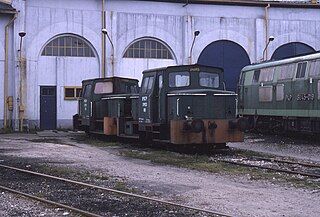
SM03 is the name of a Polish diesel locomotive class in the PKP railway operator designation. The letters SM describe a diesel shunting locomotive.

EU07 is the name for a Polish electric locomotive in service of the Polish railway operator PKP. This locomotive was designed as a mixed traffic locomotive, and as such is used both in freight and passenger traffic.
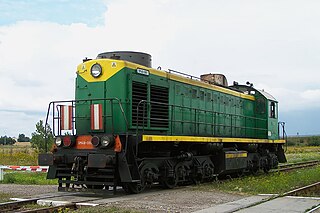
SM48 is the name for class of Soviet diesel locomotives operating in Poland for PKP. The original designation was ТЭМ2 (TEM2), and was the Soviet-built version of the ALCO RSD-1.
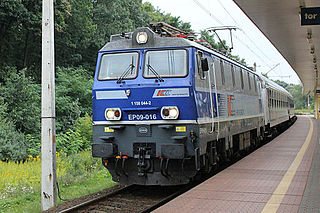
EP09 is a Polish electric locomotive used by the Polish railways, Polskie Koleje Państwowe (PKP) and produced by Pafawag of Wrocław between 1986 and 1997.

PKP Intercity is a company of the PKP Group responsible for long-distance passenger transport. It runs about 350 trains daily, connecting mainly large agglomerations and smaller towns in Poland. The company also provides most international trains to and from Poland. Trains offer Wi-Fi connectivity.
The history of rail transport in Poland dates back to the first half of the 19th century when railways were built under Prussian, Russian, and Austrian rule. Of course, "divided Poland" in the 19th century was the territory of the former Polish–Lithuanian Commonwealth and not that one of today's Republic of Poland. After Polish independence was declared on 11 November 1918, the independent Polish state administered its own railways until control was surrendered to German and Soviet occupiers during World War II.

The Double-deck Coach is a bilevel passenger railcar currently manufactured by Alstom, which acquired Bombardier Transportation in 2021 used by various European railways and Israel Railways. The current generation of double-deck coaches can be run at speeds up to 200 km/h (125 mph). Depending on their configuration, each coach can seat 100 to 150 passengers.

The Polish railways network consists of around 18,510 kilometres (11,500 mi) of track as of 2019, of which 11,998 km (7,455 mi) is electrified. The national electrification system runs at 3 kV DC.

Class E 499.1 electric locomotives were constructed and built by Škoda Works in Plzeň for use in Czechoslovakia by the ČSD. They were also used outside Czechoslovakia in Poland as class EP05 and in the Soviet Union as ЧС3 (ChS3). In North Korea, licence built copies were used.
High-speed rail service commenced in Poland on 14 December 2014, with the introduction of 20 non-tilting New Pendolino trainsets operating on 4 designated lines radiating out from Warsaw. Polish State Railways started passenger service using Pendolino trains operating at a maximum speed of 200 km/h on 80 km line Olszamowice-Zawiercie. From December 2017 there are two 200 km/h sections, 136 km long in total. All high-speed services operated by PKP in Poland are branded as Express Intercity Premium (EIP).

Pesa SA is a Polish rolling stock manufacturer based in Bydgoszcz. The name 'Pesa' derives from the initials PS which stand for Pojazdy Szynowe, 'railway vehicles' in Polish. Pesa is a successor to the Bydgoszcz repair shops of PKP Polskie Koleje Państwowe, Polish State Railways. From the 1950s until 1998 the repair shops operated under the name ZNTK Bydgoszcz, Zakłady Naprawcze Taboru Kolejowego, 'Repair Shop for Railway Rolling Stock' in Bydgoszcz.
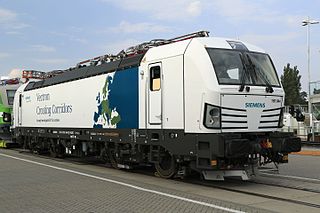
The Vectron is a locomotive series made by Siemens Mobility, introduced at the 2010 InnoTrans trade fair in four prototype versions: diesel, multi-system, and both AC and DC electric power. The diesel version has been replaced in 2018 by a dual mode locomotive which is powered by electricity on electrified sections of the track and can be switched to diesel mode on non-electrified sections. The Vectron series is reconfigurable and modular, with a Bo'Bo' wheel arrangement, and is intended as the successor to the EuroSprinter family of locomotives. A more affordable, basic version called Smartron was introduced in 2018.
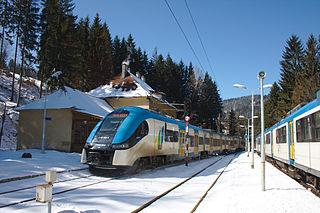
The Elf is an electric multiple unit developed by Polish rolling-stock manufacturer Pesa SA. It is intended for commuter and regional service where platform height is 55 cm (22 in). It is based on earlier EMU designs named ED59 and ED74. A Pesa Elf was exhibited at InnoTrans 2010.

The Grodzisk Mazowiecki–Zawiercie railway better known as the Central Rail Line, designated by Polish national railway infrastructure manager PKP Polskie Linie Kolejowe as rail line number 4, is a 224 km (139 mi) long railway line in Poland between Zawiercie outside the Upper Silesian Metropolitan Area and Grodzisk Mazowiecki in the suburbs of Warsaw.

HCP Z1 is a series of train carriages constructed by H. Cegielski in Poznań, which meet the UIC-Z1 standard for passenger train carriages. Several types of the wagons in the standard have been built, with over 100 units built. The main user of the carriages is PKP Intercity. The HCP Z1 is also used by the Belarusian Railway and the Polski Tabor Szynowy.

Newag Griffin is a series of Polish four-axle electric and diesel locomotives for working passenger and goods trains, produced by Newag in Nowy Sącz from 2012. The first version, the E4MSU is a mixed-traffic multi-system electric locomotive.

The Newag Dragon is a Polish six-axle electric locomotive, designed for working freight trains up to 4500 tons. The locomotive is built by Newag, between 2009–2016 at its Gliwice plant, since 2017 at the Nowy Sącz plant. By April 2020, 42 units had been built and delivered to 12 different train operating companies in Poland.